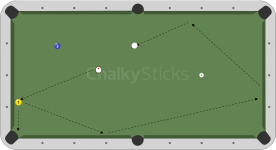Rule 2: Avoid having the keyball be frozen to a rail. We've allready seen an exception to this, with the ball "inside" the breakball on the rail. However, having a ball frozen on the rail greatly diminshes the control you have over the cueball, because you cannot bend the cueballs path before it reaches the rail. In effect you shrink the position zone that will give you a good shot at the keyball.
I'm going to show a setup of 2 balls and two choices on how to play it.
In the example bad pattern 5 we will see a triple no-no: The keyball is below the breakball, it's frozen to the rail, and you have to either draw the cueball or play some sort of incredible inside spin shot. If you get too far out with your cueball position you are pretty much doomed to do the latter, and you'd better hit it perfect. Had the breakball been further away from the keyball, you could actually stop the cueball and play a breakshot in the side. Stroking difficulties and the small position target makes this a questionable choice here.
Some will be tempted to draw and cheat the pocket because they get a bit to far out with their cueball position. DO NOT DO THAT. It's a common run-stopper, especially on tight tables. In fact you should forget about this pattern and do something different instead.
"Good" pattern 3 shows the correct way of playing this. Use the rail ball as the breakball and the other as the keyball. This gives you a HUGE area to play position for, and the rail ball is actually an ok breakball with a decent angle. We are using the rail balls limitations to our advantage. The cueball will follow or be close to the tangent line for a wide variety of angles and spins. The tangent line leads us straight into the rack (although you probably should hit a little below center for most positions).You are very unlikely to screw this up, UNLESS you chicken out and give yourself a flat angle. Don't do that.
I'm going to show a setup of 2 balls and two choices on how to play it.
In the example bad pattern 5 we will see a triple no-no: The keyball is below the breakball, it's frozen to the rail, and you have to either draw the cueball or play some sort of incredible inside spin shot. If you get too far out with your cueball position you are pretty much doomed to do the latter, and you'd better hit it perfect. Had the breakball been further away from the keyball, you could actually stop the cueball and play a breakshot in the side. Stroking difficulties and the small position target makes this a questionable choice here.
Some will be tempted to draw and cheat the pocket because they get a bit to far out with their cueball position. DO NOT DO THAT. It's a common run-stopper, especially on tight tables. In fact you should forget about this pattern and do something different instead.
"Good" pattern 3 shows the correct way of playing this. Use the rail ball as the breakball and the other as the keyball. This gives you a HUGE area to play position for, and the rail ball is actually an ok breakball with a decent angle. We are using the rail balls limitations to our advantage. The cueball will follow or be close to the tangent line for a wide variety of angles and spins. The tangent line leads us straight into the rack (although you probably should hit a little below center for most positions).You are very unlikely to screw this up, UNLESS you chicken out and give yourself a flat angle. Don't do that.
Attachments
Last edited:

